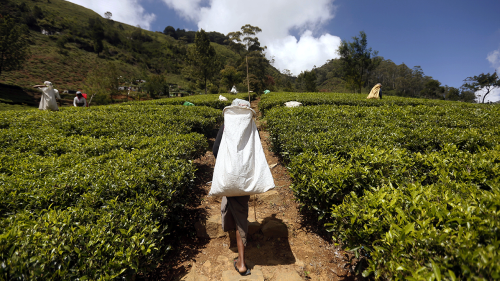Organic Mandate, Growing Solar, and Allergens

Check out the week's top stories in food, agriculture, and global development.
Top Story
An Organic Mandate amidst Crisis
The Sri Lankan government has ended price controls on food amidst an economic crisis in hopes of easing food shortages. The national government declared a state of emergency in late August, imposing food rationing and price controls. Rolling back the latter has led to a sharp rise in food prices. The economic crisis has several main causes, including a drop in tourism revenue due to the COVID-19 pandemic and mounting pressures from external debts—including $4 billion repayments due this year.
The third cause may be unexpected: an organic farming mandate. The government banned all fertilizer and pesticide imports, despite reports that an estimated 90 percent of Sri Lankan farmers use chemical fertilizers. 80 percent of farmers in support of the mandate say they would need at least a year to adjust to the shift. The tea industry, which accounts for approximately 10 percent of the country’s export earnings, expects a sharp drop in productivity this year. Rice yields are also expected to drop, which could add to the already higher prices for the staple that have jumped by nearly one third in two weeks.
Council Insights
Alcohol and the World
Today, the global alcohol industry is worth over $1.49 trillion and is one of the most influential sectors in the world. But how did alcohol become so societally important in the first place? Has alcohol played a bigger role in shaping our world than we originally thought? Register for the latest YP Nexus event on October 21 to find out!
Food & Agriculture
Looming Water Crisis
Africa is one of the regions most affected by climate variability and climate change. In the last 50 years, droughts accounted for 16 percent of natural disasters, 95 percent of climate-related deaths, and 26 percent of climate-related economic losses. A new report calls for urgent action to improve water management and increase investment in water services.
Green Gold
Hass avocados have replaced coffee crops in many rural economies in Colombia, which is now the third-largest exporter of avocado in the world. Scientists warn that the move has consequences for local wildlife.
Uncovering Allergens
Although many blue foods are allergenic, the causes of these reactions are not well documented. A team of scientists have identified a protein that regulates the growth of blood vessels in some fish as an allergen; both the allergen and the technique used to discover it are important for making mealtime safer.
Deeper Dive
How many avocados does the world eat?
Over 7 million metric tons of avocados were produced in 2019. Hass avocados are the most popular variety of avocado globally and make up 95 percent of US consumption, which has tripled since 2000. The US, Canada, Japan, Spain, and the Netherlands are top importers of the fruit, but the US imports the vast majority—77 percent. North American dominance extends to exports as well, with Mexico leading far and above all others.
Data Crunch
El Niño and Hunger:
The El Niño Southern Oscillation, a well-documented pattern of climate variability, has negative impacts on child nutrition according to a new study. Warmer El Niño conditions predict higher levels of child malnutrition across the tropics, which can lead to stunting years later.
Resilience
Global Hunger Index
The world will not achieve SDG 2, Zero Hunger, by 2030 according to the 2021 Global Hunger Index. Conflict, climate change, and the COVID-19 pandemic have intertwined to reverse global progress, and 47 countries will not achieve even low levels of hunger if current trends continue.
Biodiversity Matters
An estimated one million species are at risk of extinction, and that level of biodiversity loss could have major consequences for agriculture and ecosystems around the world. At the UN Convention on Biodiversity, commitments to limit farm runoff, ensure safe and sustainable hunting and fishing of wild species, and plan the optimal areas for farming are on the agenda.
Big Ideas
Methane-Busting Garlic
Agriculture is the leading source of global methane, accounting for about 40 percent, the bulk of which comes from livestock. Farmers are adopting innovative solutions, including garlic and citrus-infused pellets that disrupt the methane-producing enzymes in the digestion process.
Growing Solar
The new science of agrovoltaics—incorporating solar panels into farm fields—is showing promise for increasing yields while saving water. Solar panels shade plants, helping the crops save water, and the plants’ transpiration cools the panels, boosting efficiency.
DC Report
Supply Chain Woes
Agriculture Secretary Tom Vilsack voiced concerns over crop and food shortages for farmers, schools, and other large national retailers because of pandemic-related issues. The US agriculture sector has been hit hard as farmers and ranchers see rising prices in machinery and necessary equipment to sell their commodities. Biden met with private sector leaders to discuss the bottlenecks in the supply chain and make commitments on finding appropriate solutions.
Big Actors
Pledge to Minimize Methane
Methane, a byproduct of ruminant animal agriculture and rice production, has risen on the political agenda this year. Support from Japan, Canada, and Germany brings the total to 34 parties that have pledged to reduce emissions by about a third over the next decade. Major emitters including China, Russia, India, and Brazil have yet to sign up.
Trade & Commodities
Soybean Surge
Prices for US organic soybeans used for livestock feed and soy milk have surged to record highs, triggering price increases for food including organically raised chicken. At the same time, the $56 billion US organic food sector is grappling with a shortage of shipping containers and a tight labor market.
Higher Prices Here to Stay
Food prices have reached a 10-year high, and international food company Kraft Heinz is raising its prices in response. The company’s CEO recently said that consumers need to get used to the change. Other factors pushing Kraft Heinz’s decision include shortages of truck drivers, rising logistics costs, and general labor shortages.

